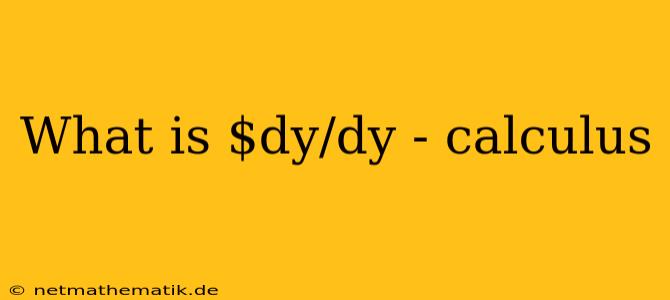The concept of dy/dx is fundamental to calculus, representing the derivative of a function. It signifies the instantaneous rate of change of a dependent variable (y) with respect to an independent variable (x). However, the expression dy/dy might seem unusual at first glance. Let's delve into the meaning and implications of this seemingly simple expression.
Understanding dy/dy
The expression dy/dy can be interpreted as the derivative of a function with respect to itself. In essence, we are asking how the function changes as its own input changes. This concept might seem trivial, but it holds significant implications in calculus.
Simplifying dy/dy
When you encounter dy/dy, it's crucial to understand that it simplifies to 1. Here's why:
-
The Chain Rule: The chain rule in calculus states that the derivative of a composite function is the product of the derivative of the outer function and the derivative of the inner function. Let's consider y = f(x), where f(x) is an arbitrary function. Applying the chain rule, we get:
d(f(x))/dx = d(f(x))/dy * dy/dx -
The Identity Property: Now, let's set x = y. This means we are considering the derivative of the function with respect to itself. The equation becomes:
df(y)/dy = df(y)/dy * dy/dy -
Simplification: Since the left-hand side and the first part of the right-hand side are identical, we can cancel them out, resulting in:
1 = dy/dy
Applications of dy/dy
While dy/dy might appear redundant, it serves as a valuable tool in various calculus applications. Here are some examples:
1. Change of Variables
In integration, we often employ the technique of substitution. The dy/dy expression plays a crucial role in this process. When we substitute u = f(x) in an integral, we also need to change the differential element dx. This is where the relationship dy/dy = 1 proves useful:
dx = (du/dy) * (dy/dx) = (du/dy) * 1 = du/dy
2. Implicit Differentiation
Implicit differentiation is a technique used to find the derivative of a function when it is not explicitly defined in terms of a single variable. Consider an equation like x² + y² = 25. We can differentiate both sides with respect to x, treating y as a function of x. This process involves dy/dy to express the derivative of y with respect to itself.
3. Parameterization
When working with parametric equations, where x and y are both expressed as functions of a parameter t, we can calculate the derivative dy/dx using the chain rule:
dy/dx = (dy/dt) / (dx/dt)
In this context, dy/dy appears indirectly as a component of the chain rule.
Conclusion
While dy/dy may seem like a straightforward expression, its meaning and implications extend beyond its apparent simplicity. It serves as a fundamental element in various calculus applications, including change of variables, implicit differentiation, and parameterization. Recognizing the significance of dy/dy strengthens our understanding of the interconnectedness of concepts within calculus.
